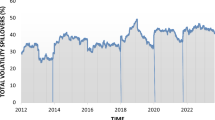Abstract
In this article, the traditional price change hedge ratio estimation method is extended by applying the theory of cointegration in the case of cross-hedging of spot exchange risk of the Belgian franc (BF), the Italian lira (IL), and the Dutch guilder (NG) with U.S. Dollar Index futures contracts. Previous studies ignore the last period's equilibrium error and short-run deviations. The findings of this study indicate that the hedge ratio estimated by the error correction method is superior to that obtained from the traditional method, as evidenced by the likelihood ratio test and out-of-sample forecasts. Hedgers will be able to control the risk of their portfolios more effectively at a lower cost.
Similar content being viewed by others
References
Akaike, H., “A New Look at Statistical Model Identification.” IEEE Trans. Auto. Control 19, 716–723, (1974).
Baillie, R. and T.Bollerslev, “Common Stochastic Trends in a System of Exchange Rates.” Journal of Finance 44, 167–181, (1989).
Baillie, R. and T.Bollerslev, “Cointegration, Fractional Cointegration, and Exchange Rate Dynamics.” Journal of Finance 49, 737–745, (1994).
Benet, B., “Commodity Futures Cross-Hedging of Foreign Exchange Exposure.” Journal of Futures Markets 10, 287–306, (1990).
Benet, B., “Hedge period Length and Ex-Ante Futures hedging Effectiveness: The Case of Foreign Exchange Risk Cross Hedges.” Journal of Futures markets 12, 163–175, (1992).
Braga, F., L.Martin, and K.Meilke, “Cross-Hedging the Italian Lira/U.S. Dollar Exchange Rate with Deutsch Mark Futures.” Journal of Futures Markets 9, 87–100, (1989).
Brown, S., “A Reformulation of the Portfolio model of Hedging.” American Journal of Agricultural Economics 67, 508–572, (1985).
Davidson, R. and J.MacKinnon, Estimation and Inference in Econometrics. New york: Oxford University Press, 1993.
Dickey, D. and W.Fullter, “The Likelihood Ratio Statistics for Autoregressive Time Series with a Unit Root.” Econometrica 49, 1057–1072, (1981).
Diebold, F., J.Gardeazabel, and K.Yilenarz. “On Cointegration and Exchange Rate Dynamics.” Journal of Finance 49, 727–735, (1994).
Eaker, M. and D. Grant, “Cross-Hedging Foreign Currency Risk.” Journal of International Money and Finance, 85–105, (1987).
Ederington, L., “The Hedging Performance of the New Futures Markets.” Journal of Finance 34, 157–170, (1979).
Engle, R. and C.Granger, “Cointegration and error Correction Representation, Estimation, and Testing.” Econometrica 55, 251–276, (1987).
Ghosh, A., “The Hedging Effectiveness of Foreign Currency Futures: Empirical Evidence from an Error Correction Model.” The Journal of Multinational Financial Management 5, 53–63, (1995).
Granger, C., “Some Properties of Time Series Data in Econometric Model Specification.” Journal of Econometrics 16, 121–130, (1981).
Granger, C. and P. Newbold, “Spurious Regressions in Econometrics.” Journal of Econometrics, 111–120, (1974).
Hill, J. and T.Schneeweis, “The Hedging Effectiveness of Foreign Currency Futures.” Journal of Financial Reearch 5, 95–104, (1982).
Johnson, L., “The Theory of Hedging and Speculation in Commodity Futures.” Review of Economic Studies 27, 139–151, (1960).
MacKinnon, J., “Critical Values for Cointegration Tests.” In R. Engle and C. Granger, eds., Long-Run Economic Relationships Readings in Cointegration. New York: Oxford University Press.
Phillips, P. and P.Perron, “Testing for a Unit Root in Time Series Regression.” Biometrika 75, 335–346, (1988).
Stein, J., “The Simultaneous Determination of Spot and Futures Prices.” American Economic Review 51, 1012–1025, (1961).
Wilson, William W., “Hedging Effectiveness of U.S. Wheat Futures Markets.” Review of Research in Futures Markets 3, 64–67, (1983).
Witt, H., T.Schroeder, and M.Hayenga, “Comparison of Analytical Approaches for Estimating Hedge Ratios for Agricultural Commodities.” Journal of Futures Markers 7, 135–146, (1987).
Working, H., ‘Futures Trading and Hedging.” American Economic Review 43, 314–343, (1953).
Working, H., “New Concepts Concerning Futures Markets and Prices.” American Economic Review 52, 432–459, (1962).
Author information
Authors and Affiliations
Rights and permissions
About this article
Cite this article
Ghosh, A. Cross-hedging foreign currency risk: Empirical evidence from an error correction model. Rev Quant Finan Acc 6, 223–231 (1996). https://doi.org/10.1007/BF00245181
Issue Date:
DOI: https://doi.org/10.1007/BF00245181




